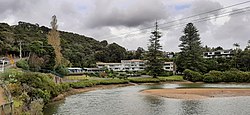Te Haumi
Te Haumi | |
|---|---|
 | |
 | |
| Coordinates: 35°18′07″S 174°05′55″E / 35.3019°S 174.0985°E | |
| Region | Northland Region |
| District | Far North District |
| Ward | Bay of Islands-Whangaroa Ward |
| Electorates | |
| Government | |
| • Territorial Authority | Far North District Council |
| • Regional council | Northland Regional Council |
| Area | |
| • Total | 0.62 km2 (0.24 sq mi) |
| Population (2018 Census)[2] | |
| • Total | 375 |
| • Density | 600/km2 (1,600/sq mi) |
Te Haumi is a settlement south-east of Paihia and north-west of Opua in the Bay of Islands area of Northland Region, New Zealand.[3]
The Rangatira (Chief) Tohitapu lived at Te Haumi until his death in 1833.[4] He is remembered in the naming of Tohitapu Road.
Demographics[edit]
Te Haumi is in two SA1 statistical areas which cover 0.62 km2 (0.24 sq mi).[1] The SA1 areas are part of the larger Opua statistical area.[5]
| Year | Pop. | ±% p.a. |
|---|---|---|
| 2006 | 390 | — |
| 2013 | 360 | −1.14% |
| 2018 | 375 | +0.82% |
| Source: [2] | ||
Te Haumi had a population of 375 at the 2018 New Zealand census, an increase of 15 people (4.2%) since the 2013 census, and a decrease of 15 people (−3.8%) since the 2006 census. There were 180 households, comprising 174 males and 204 females, giving a sex ratio of 0.85 males per female, with 36 people (9.6%) aged under 15 years, 27 (7.2%) aged 15 to 29, 186 (49.6%) aged 30 to 64, and 129 (34.4%) aged 65 or older.
Ethnicities were 84.8% European/Pākehā, 17.6% Māori, 3.2% Pacific peoples, 2.4% Asian, and 0.8% other ethnicities. People may identify with more than one ethnicity.
Although some people chose not to answer the census's question about religious affiliation, 47.2% had no religion, 43.2% were Christian, 0.8% were Buddhist and 2.4% had other religions.
Of those at least 15 years old, 75 (22.1%) people had a bachelor's or higher degree, and 42 (12.4%) people had no formal qualifications. 33 people (9.7%) earned over $70,000 compared to 17.2% nationally. The employment status of those at least 15 was that 144 (42.5%) people were employed full-time, 45 (13.3%) were part-time, and 6 (1.8%) were unemployed.[2]
References[edit]
- ^ a b "ArcGIS Web Application". statsnz.maps.arcgis.com. Retrieved 14 April 2022.
- ^ a b c "Statistical area 1 dataset for 2018 Census". Statistics New Zealand. March 2020. 7000313 and 7000314.
- ^ Roger Smith, GeographX (2005). The Geographic Atlas of New Zealand. Robbie Burton. map 20. ISBN 1-877333-20-4.
- ^ Smith, S. Percy – Maori Wars of the Nineteenth Century (Christchurch 1910) page 458. online at NZETC
- ^ 2018 Census place summary: Opua (Far North District)
